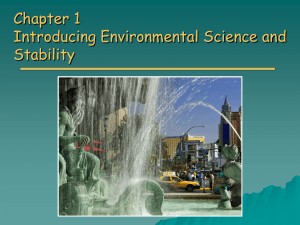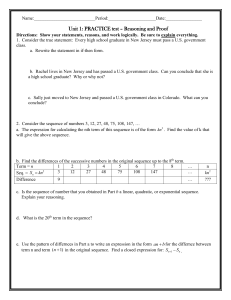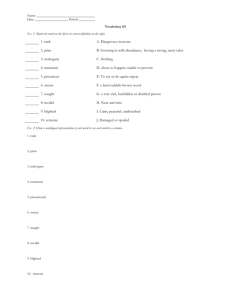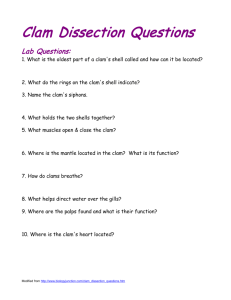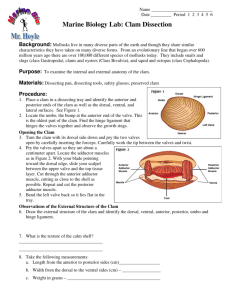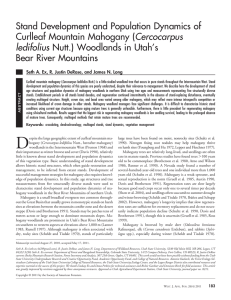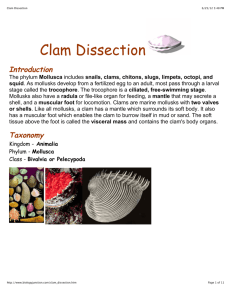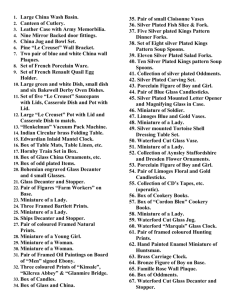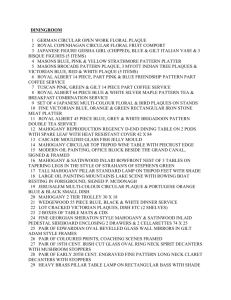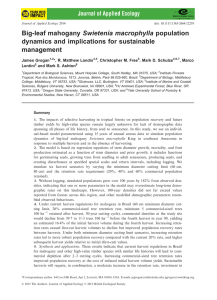APES Test: Introduction - AP Environmental Science
advertisement
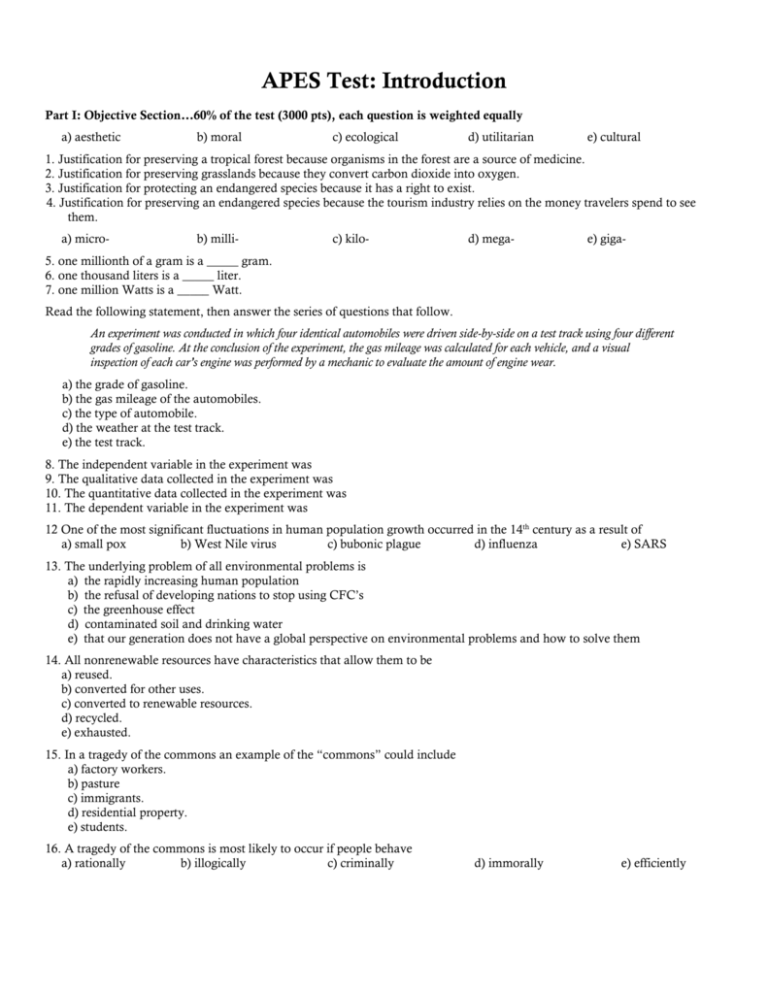
APES Test: Introduction Part I: Objective Section...60% of the test (3000 pts), each question is weighted equally a) aesthetic b) moral c) ecological d) utilitarian e) cultural 1. Justification for preserving a tropical forest because organisms in the forest are a source of medicine. 2. Justification for preserving grasslands because they convert carbon dioxide into oxygen. 3. Justification for protecting an endangered species because it has a right to exist. 4. Justification for preserving an endangered species because the tourism industry relies on the money travelers spend to see them. a) micro- b) milli- c) kilo- d) mega- e) giga- 5. one millionth of a gram is a _____ gram. 6. one thousand liters is a _____ liter. 7. one million Watts is a _____ Watt. Read the following statement, then answer the series of questions that follow. An experiment was conducted in which four identical automobiles were driven side-by-side on a test track using four different grades of gasoline. At the conclusion of the experiment, the gas mileage was calculated for each vehicle, and a visual inspection of each car’s engine was performed by a mechanic to evaluate the amount of engine wear. a) the grade of gasoline. b) the gas mileage of the automobiles. c) the type of automobile. d) the weather at the test track. e) the test track. 8. The independent variable in the experiment was 9. The qualitative data collected in the experiment was 10. The quantitative data collected in the experiment was 11. The dependent variable in the experiment was 12 One of the most significant fluctuations in human population growth occurred in the 14th century as a result of a) small pox b) West Nile virus c) bubonic plague d) influenza e) SARS 13. The underlying problem of all environmental problems is a) the rapidly increasing human population b) the refusal of developing nations to stop using CFC’s c) the greenhouse effect d) contaminated soil and drinking water e) that our generation does not have a global perspective on environmental problems and how to solve them 14. All nonrenewable resources have characteristics that allow them to be a) reused. b) converted for other uses. c) converted to renewable resources. d) recycled. e) exhausted. 15. In a tragedy of the commons an example of the “commons” could include a) factory workers. b) pasture c) immigrants. d) residential property. e) students. 16. A tragedy of the commons is most likely to occur if people behave a) rationally b) illogically c) criminally d) immorally e) efficiently 17. The main argument for boycotting all products made with the tropical hardwood, mahogany, is that: a) logging mahogany is unsustainable, and it opens rainforest land to other types of encroachment b) mahogany trees are an endangered species c) mahogany is grown mainly in Belize, which is a brutal and repressive dictatorship d) mahogany trees are the principal habitat for the endangered tree sloth e) mahogany processing produces large amounts of methane, promoting global warming 18. In a total free-market system, commercial enterprises maximize profits by paying only ____________ costs and ignoring ____________. a) indirect; direct costs b) intangible; externalities c) direct; externalities d) mandatory; supply and demand e) direct; the discount factor 19. Many natural organisms and ecosystems perform service functions that are beneficial to humans. These include all of the following except: a) bees pollinating crops b) bacteria fixing nitrogen in the ocean c) salt marshes convert toxic compounds to nontoxic forms d) biological degradation of toxic material applied to land e) water in the atmosphere combines with sulfurous pollutants and rains to the ground 20. In order to explain a set of supported hypotheses, scientists may propose a(n) a) fact b) operational definition c) super hypothesis d) conclusion e) model 21. Non-point sources of pollution include all of the following except a) overspill from a stockyard. b) runoff from croplands. c) a smokestack from a power plant. d) fertilizer overflow from lawns. e) urban runoff from streets. 22. In science a) deductive reasoning is considered far more useful than inductive reasoning due to the infallibility of the conclusions that result from inductive reasoning. b) error analysis causes great confusion. c) most conclusions are 100% certain. d) inductive reasoning is combined with deductive reasoning to analyze conclusions. e) measurements are considered meaningless when they are accompanied by an estimate of uncertainty. 23. Which of the following statements is the best example of a hypothesis? a) If more carbon dioxide is added to the atmosphere, the temperature of the Earth will change. b) If insects are present on crops, pesticides are needed. c) If the amount of ozone in the atmosphere changes, life on Earth will suffer. d) If the amount of mercury ingested by children increased, their cognitive ability decreases e) If the size of a population increases, it has huge repercussions on the environment. 24. Precision and accuracy: a) refer to a series of logically connected statements b) are comparable in their importance for scientific work c) always involve inductive and deductive proof d) always change in value e) are not equivalent 25. Which of the following statements is true? a) Science is limited by technology. b) Scientists quickly identify ideas at the frontiers of science that will become accepted theories. c) The media carefully screens stories and only rarely reports claims that are not supported by the majority of the scientific community. d) Science is unbiased. e) All of the statements are true. Part II: Free Response Question...40% of the test (2000 pts) For thousands of years, clams have been dug up along the beaches of California for food, first by Native Americans, and these days often by tourists. Today, the clam population is at an all-time low, and many scientists agree that several species of clams will inevitably become extinct in California. Dr. Kim, a marine biologist, believes that DDT dumped into the ocean during the 1950’s and 60’s could be another factor in the dramatic decrease in the clam population. A) Write an argument to explain why the decline in the clam population could be considered an example of a tragedy of the commons. B) Identify and describe two strategies that could be employed to prevent any decline in the clam population due to a tragedy of the commons. C) Design a controlled experiment to support or refute the claim by Dr. Kim that DDT is playing a role in the clam’s demise. Include a detailed description of the experiment that includes the hypothesis being tested, a description of the data being collected, and identification of the dependent and independent variables in the experiment. Part III: Extra Credit (200 pts) Only responses written at the end of the FRQ will be considered. Easter Island was colonized by what race of people.



